Jufeng Yang
Deep Learning in Concealed Dense Prediction
Apr 15, 2025Abstract:Deep learning is developing rapidly and handling common computer vision tasks well. It is time to pay attention to more complex vision tasks, as model size, knowledge, and reasoning capabilities continue to improve. In this paper, we introduce and review a family of complex tasks, termed Concealed Dense Prediction (CDP), which has great value in agriculture, industry, etc. CDP's intrinsic trait is that the targets are concealed in their surroundings, thus fully perceiving them requires fine-grained representations, prior knowledge, auxiliary reasoning, etc. The contributions of this review are three-fold: (i) We introduce the scope, characteristics, and challenges specific to CDP tasks and emphasize their essential differences from generic vision tasks. (ii) We develop a taxonomy based on concealment counteracting to summarize deep learning efforts in CDP through experiments on three tasks. We compare 25 state-of-the-art methods across 12 widely used concealed datasets. (iii) We discuss the potential applications of CDP in the large model era and summarize 6 potential research directions. We offer perspectives for the future development of CDP by constructing a large-scale multimodal instruction fine-tuning dataset, CvpINST, and a concealed visual perception agent, CvpAgent.
Devil is in the Uniformity: Exploring Diverse Learners within Transformer for Image Restoration
Mar 26, 2025Abstract:Transformer-based approaches have gained significant attention in image restoration, where the core component, i.e, Multi-Head Attention (MHA), plays a crucial role in capturing diverse features and recovering high-quality results. In MHA, heads perform attention calculation independently from uniform split subspaces, and a redundancy issue is triggered to hinder the model from achieving satisfactory outputs. In this paper, we propose to improve MHA by exploring diverse learners and introducing various interactions between heads, which results in a Hierarchical multI-head atteNtion driven Transformer model, termed HINT, for image restoration. HINT contains two modules, i.e., the Hierarchical Multi-Head Attention (HMHA) and the Query-Key Cache Updating (QKCU) module, to address the redundancy problem that is rooted in vanilla MHA. Specifically, HMHA extracts diverse contextual features by employing heads to learn from subspaces of varying sizes and containing different information. Moreover, QKCU, comprising intra- and inter-layer schemes, further reduces the redundancy problem by facilitating enhanced interactions between attention heads within and across layers. Extensive experiments are conducted on 12 benchmarks across 5 image restoration tasks, including low-light enhancement, dehazing, desnowing, denoising, and deraining, to demonstrate the superiority of HINT. The source code is available in the supplementary materials.
ICFRNet: Image Complexity Prior Guided Feature Refinement for Real-time Semantic Segmentation
Aug 25, 2024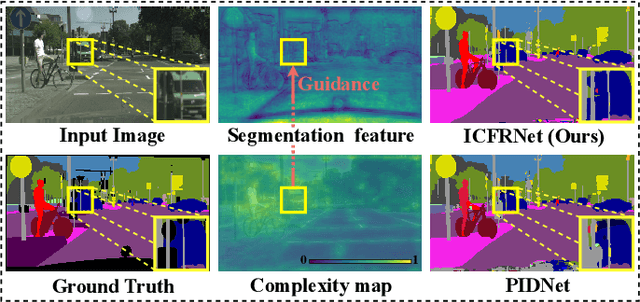
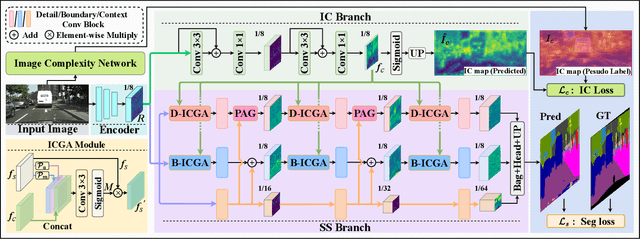

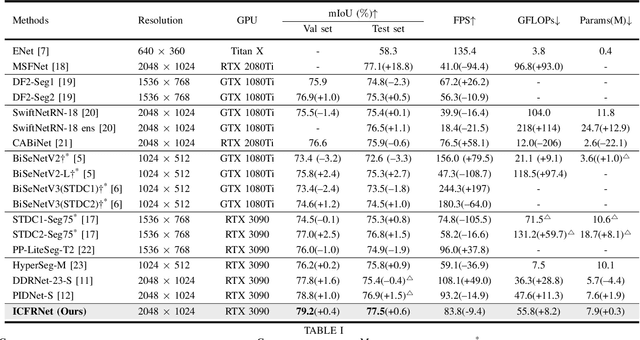
Abstract:In this paper, we leverage image complexity as a prior for refining segmentation features to achieve accurate real-time semantic segmentation. The design philosophy is based on the observation that different pixel regions within an image exhibit varying levels of complexity, with higher complexities posing a greater challenge for accurate segmentation. We thus introduce image complexity as prior guidance and propose the Image Complexity prior-guided Feature Refinement Network (ICFRNet). This network aggregates both complexity and segmentation features to produce an attention map for refining segmentation features within an Image Complexity Guided Attention (ICGA) module. We optimize the network in terms of both segmentation and image complexity prediction tasks with a combined loss function. Experimental results on the Cityscapes and CamViD datasets have shown that our ICFRNet achieves higher accuracy with a competitive efficiency for real-time segmentation.
LAKE-RED: Camouflaged Images Generation by Latent Background Knowledge Retrieval-Augmented Diffusion
Apr 07, 2024
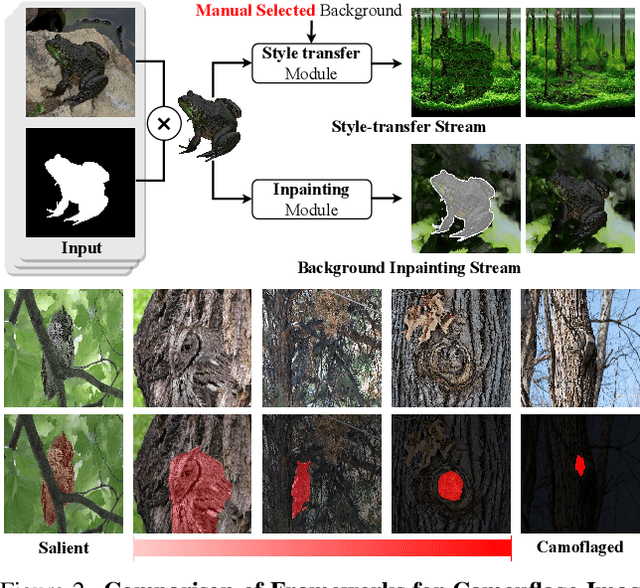

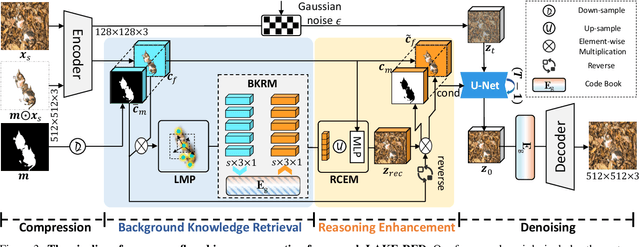
Abstract:Camouflaged vision perception is an important vision task with numerous practical applications. Due to the expensive collection and labeling costs, this community struggles with a major bottleneck that the species category of its datasets is limited to a small number of object species. However, the existing camouflaged generation methods require specifying the background manually, thus failing to extend the camouflaged sample diversity in a low-cost manner. In this paper, we propose a Latent Background Knowledge Retrieval-Augmented Diffusion (LAKE-RED) for camouflaged image generation. To our knowledge, our contributions mainly include: (1) For the first time, we propose a camouflaged generation paradigm that does not need to receive any background inputs. (2) Our LAKE-RED is the first knowledge retrieval-augmented method with interpretability for camouflaged generation, in which we propose an idea that knowledge retrieval and reasoning enhancement are separated explicitly, to alleviate the task-specific challenges. Moreover, our method is not restricted to specific foreground targets or backgrounds, offering a potential for extending camouflaged vision perception to more diverse domains. (3) Experimental results demonstrate that our method outperforms the existing approaches, generating more realistic camouflage images.
Spread Your Wings: A Radial Strip Transformer for Image Deblurring
Mar 30, 2024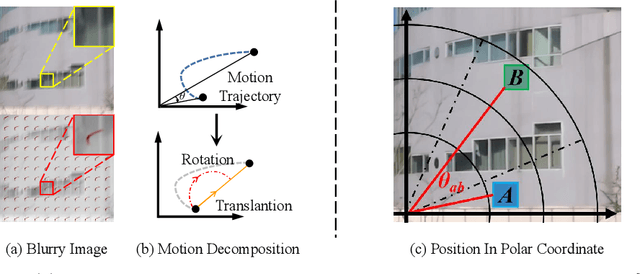
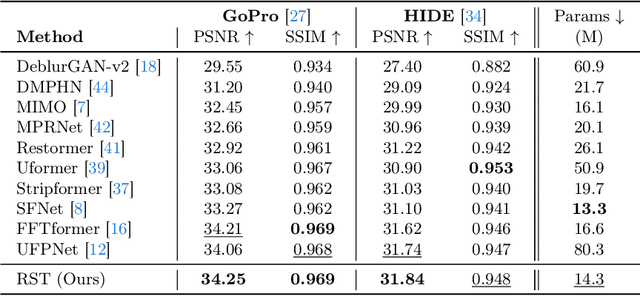


Abstract:Exploring motion information is important for the motion deblurring task. Recent the window-based transformer approaches have achieved decent performance in image deblurring. Note that the motion causing blurry results is usually composed of translation and rotation movements and the window-shift operation in the Cartesian coordinate system by the window-based transformer approaches only directly explores translation motion in orthogonal directions. Thus, these methods have the limitation of modeling the rotation part. To alleviate this problem, we introduce the polar coordinate-based transformer, which has the angles and distance to explore rotation motion and translation information together. In this paper, we propose a Radial Strip Transformer (RST), which is a transformer-based architecture that restores the blur images in a polar coordinate system instead of a Cartesian one. RST contains a dynamic radial embedding module (DRE) to extract the shallow feature by a radial deformable convolution. We design a polar mask layer to generate the offsets for the deformable convolution, which can reshape the convolution kernel along the radius to better capture the rotation motion information. Furthermore, we proposed a radial strip attention solver (RSAS) as deep feature extraction, where the relationship of windows is organized by azimuth and radius. This attention module contains radial strip windows to reweight image features in the polar coordinate, which preserves more useful information in rotation and translation motion together for better recovering the sharp images. Experimental results on six synthesis and real-world datasets prove that our method performs favorably against other SOTA methods for the image deblurring task.
Look-Around Before You Leap: High-Frequency Injected Transformer for Image Restoration
Mar 30, 2024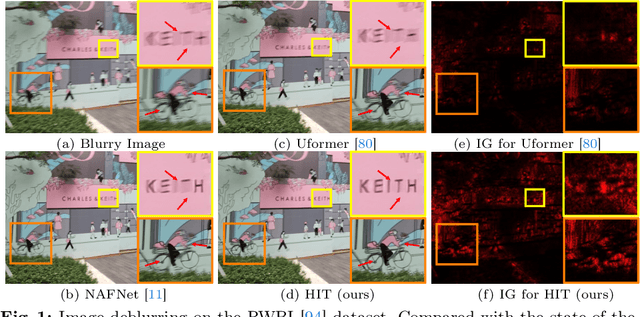
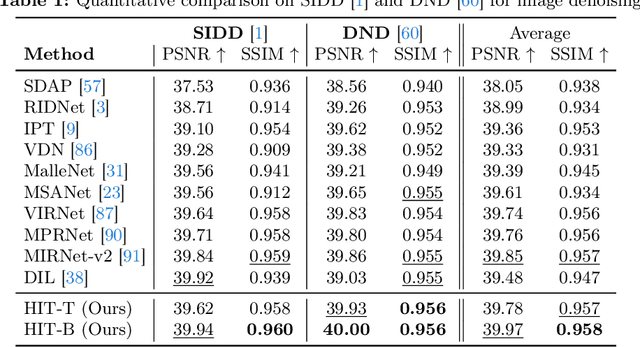
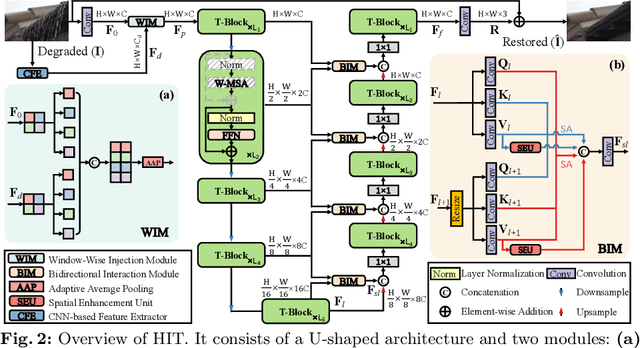
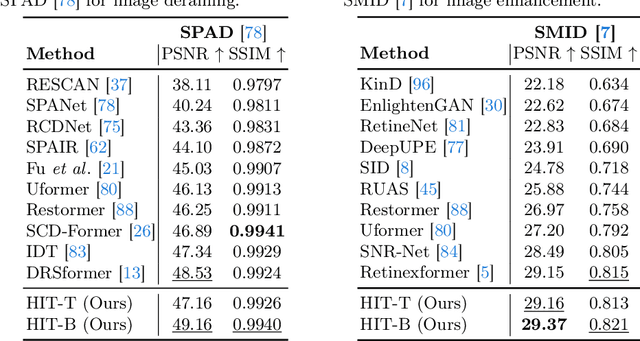
Abstract:Transformer-based approaches have achieved superior performance in image restoration, since they can model long-term dependencies well. However, the limitation in capturing local information restricts their capacity to remove degradations. While existing approaches attempt to mitigate this issue by incorporating convolutional operations, the core component in Transformer, i.e., self-attention, which serves as a low-pass filter, could unintentionally dilute or even eliminate the acquired local patterns. In this paper, we propose HIT, a simple yet effective High-frequency Injected Transformer for image restoration. Specifically, we design a window-wise injection module (WIM), which incorporates abundant high-frequency details into the feature map, to provide reliable references for restoring high-quality images. We also develop a bidirectional interaction module (BIM) to aggregate features at different scales using a mutually reinforced paradigm, resulting in spatially and contextually improved representations. In addition, we introduce a spatial enhancement unit (SEU) to preserve essential spatial relationships that may be lost due to the computations carried out across channel dimensions in the BIM. Extensive experiments on 9 tasks (real noise, real rain streak, raindrop, motion blur, moir\'e, shadow, snow, haze, and low-light condition) demonstrate that HIT with linear computational complexity performs favorably against the state-of-the-art methods. The source code and pre-trained models will be available at https://github.com/joshyZhou/HIT.
Seeing the Unseen: A Frequency Prompt Guided Transformer for Image Restoration
Mar 30, 2024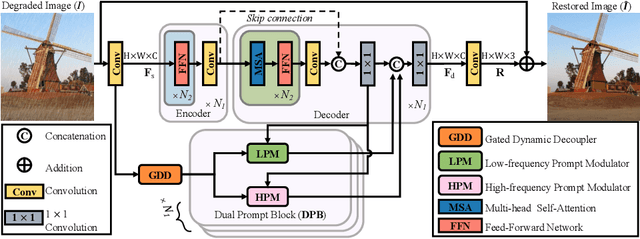
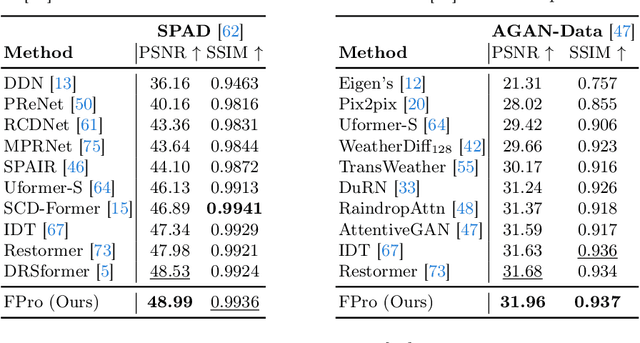
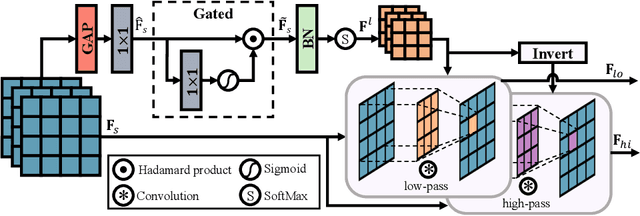
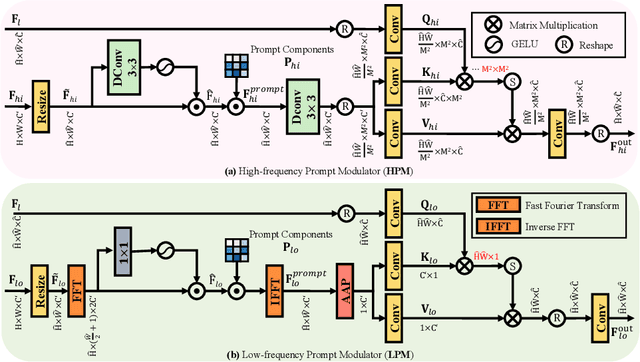
Abstract:How to explore useful features from images as prompts to guide the deep image restoration models is an effective way to solve image restoration. In contrast to mining spatial relations within images as prompt, which leads to characteristics of different frequencies being neglected and further remaining subtle or undetectable artifacts in the restored image, we develop a Frequency Prompting image restoration method, dubbed FPro, which can effectively provide prompt components from a frequency perspective to guild the restoration model address these differences. Specifically, we first decompose input features into separate frequency parts via dynamically learned filters, where we introduce a gating mechanism for suppressing the less informative elements within the kernels. To propagate useful frequency information as prompt, we then propose a dual prompt block, consisting of a low-frequency prompt modulator (LPM) and a high-frequency prompt modulator (HPM), to handle signals from different bands respectively. Each modulator contains a generation process to incorporate prompting components into the extracted frequency maps, and a modulation part that modifies the prompt feature with the guidance of the decoder features. Experimental results on commonly used benchmarks have demonstrated the favorable performance of our pipeline against SOTA methods on 5 image restoration tasks, including deraining, deraindrop, demoir\'eing, deblurring, and dehazing. The source code and pre-trained models will be available at https://github.com/joshyZhou/FPro.
Harmonizing Light and Darkness: A Symphony of Prior-guided Data Synthesis and Adaptive Focus for Nighttime Flare Removal
Mar 30, 2024



Abstract:Intense light sources often produce flares in captured images at night, which deteriorates the visual quality and negatively affects downstream applications. In order to train an effective flare removal network, a reliable dataset is essential. The mainstream flare removal datasets are semi-synthetic to reduce human labour, but these datasets do not cover typical scenarios involving multiple scattering flares. To tackle this issue, we synthesize a prior-guided dataset named Flare7K*, which contains multi-flare images where the brightness of flares adheres to the laws of illumination. Besides, flares tend to occupy localized regions of the image but existing networks perform flare removal on the entire image and sometimes modify clean areas incorrectly. Therefore, we propose a plug-and-play Adaptive Focus Module (AFM) that can adaptively mask the clean background areas and assist models in focusing on the regions severely affected by flares. Extensive experiments demonstrate that our data synthesis method can better simulate real-world scenes and several models equipped with AFM achieve state-of-the-art performance on the real-world test dataset.
MCANet: Medical Image Segmentation with Multi-Scale Cross-Axis Attention
Dec 20, 2023Abstract:Efficiently capturing multi-scale information and building long-range dependencies among pixels are essential for medical image segmentation because of the various sizes and shapes of the lesion regions or organs. In this paper, we present Multi-scale Cross-axis Attention (MCA) to solve the above challenging issues based on the efficient axial attention. Instead of simply connecting axial attention along the horizontal and vertical directions sequentially, we propose to calculate dual cross attentions between two parallel axial attentions to capture global information better. To process the significant variations of lesion regions or organs in individual sizes and shapes, we also use multiple convolutions of strip-shape kernels with different kernel sizes in each axial attention path to improve the efficiency of the proposed MCA in encoding spatial information. We build the proposed MCA upon the MSCAN backbone, yielding our network, termed MCANet. Our MCANet with only 4M+ parameters performs even better than most previous works with heavy backbones (e.g., Swin Transformer) on four challenging tasks, including skin lesion segmentation, nuclei segmentation, abdominal multi-organ segmentation, and polyp segmentation. Code is available at https://github.com/haoshao-nku/medical_seg.
Emotion Recognition from Multiple Modalities: Fundamentals and Methodologies
Aug 18, 2021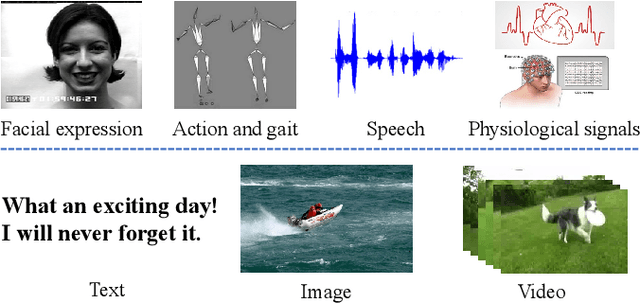

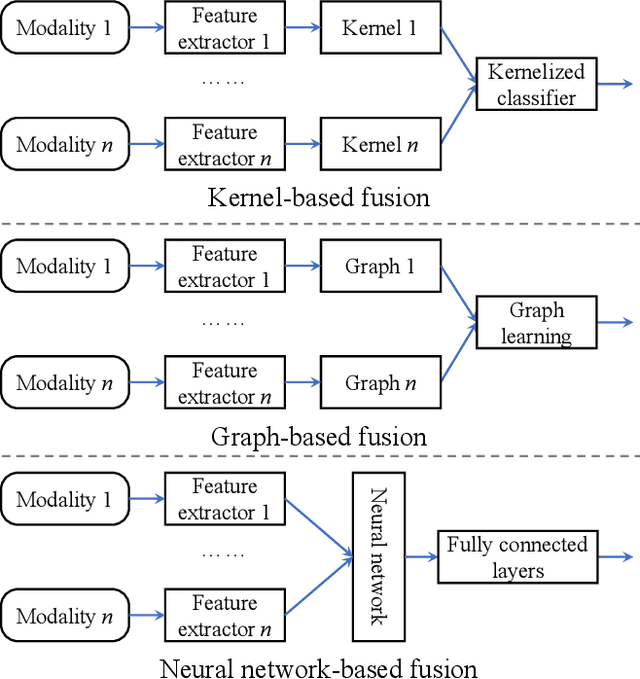
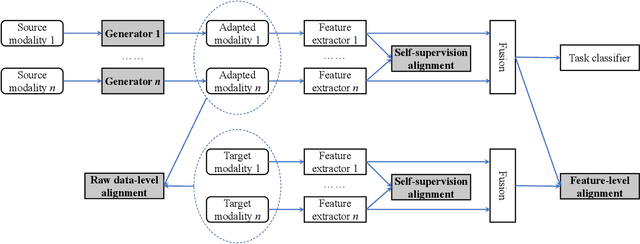
Abstract:Humans are emotional creatures. Multiple modalities are often involved when we express emotions, whether we do so explicitly (e.g., facial expression, speech) or implicitly (e.g., text, image). Enabling machines to have emotional intelligence, i.e., recognizing, interpreting, processing, and simulating emotions, is becoming increasingly important. In this tutorial, we discuss several key aspects of multi-modal emotion recognition (MER). We begin with a brief introduction on widely used emotion representation models and affective modalities. We then summarize existing emotion annotation strategies and corresponding computational tasks, followed by the description of main challenges in MER. Furthermore, we present some representative approaches on representation learning of each affective modality, feature fusion of different affective modalities, classifier optimization for MER, and domain adaptation for MER. Finally, we outline several real-world applications and discuss some future directions.
 Add to Chrome
Add to Chrome Add to Firefox
Add to Firefox Add to Edge
Add to Edge